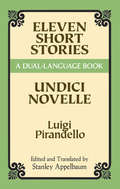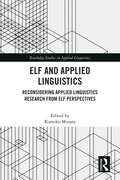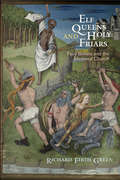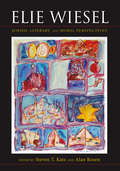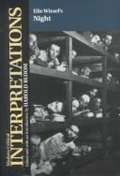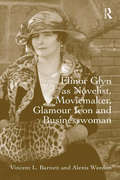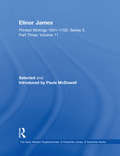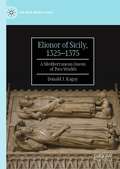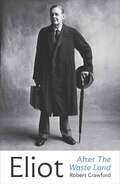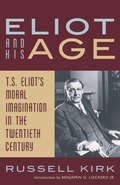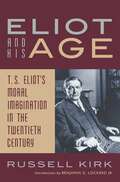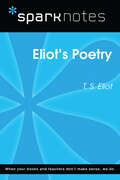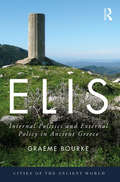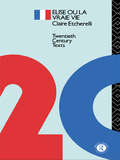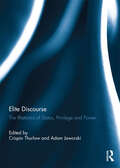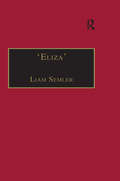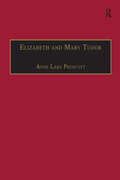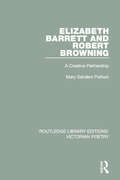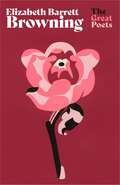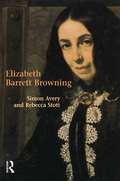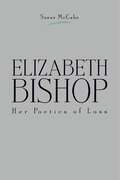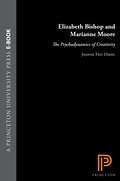- Table View
- List View
Eleven Short Stories: A Dual-Language Book (Dover Dual Language Italian)
by Luigi PirandelloWinner of the 1934 Nobel Prize for literature, Luigi Pirandello (1867 - 1936) is best known for such landmark plays as Six Characters in Search of an Author. One of the great literary figures of the twentieth century, he also distinguished himself in a vast outpouring of short stories, poetry, novels, and essays. The stories often provided the seeds for later novels and plays.The 11 tales included in this collection are among his best. Presented in the original Italian with excellent new English translations on facing pages, they offer students of Italian language and literature a unique learning aid and a treasury of superb fiction by a modern master.The stories range in time from the earliest known tale, "Little Hut," a study of rural passions written in 1884, to "Mrs. Frola and Mr. Ponza, Her Son-in-Law," a quintessential Pirandello story about the relativity of truth and the impossibility of penetrating other people's minds. Published in 1917, it formed the basis of Pirandello's first major play, Right You Are If You Think You Are. In addition to these narratives, the volume also includes "Citrons from Sicily," "With Other Eyes," "A Voice," "The Fly," "The Oil Jar," "It's Not to be Taken Seriously," "Think it Over, Giacomino!," "A Character's Tragedy," and "A Prancing Horse."Accompanying the stories are a biographical and critical introduction to Pirandello and his work, brief introductions to each of the stories and explanatory footnotes.
ELF and Applied Linguistics: Reconsidering Applied Linguistics Research from ELF Perspectives (Routledge Studies in Applied Linguistics)
by Kumiko MurataWith help from a global cast of scholars, Kumiko Murata explores the remodelling of the discipline of applied linguistics, which traditionally regarded Anglophone native-speaker English as the standard for English as a lingua franca (ELF). This edited volume probes the dichotomy between the current focus of applied linguistic research and a drastically changed English use in a globalised world. This division is approached from diverse perspectives and with the overarching understanding of ELF as an indispensable area of applied linguistics research. The volume includes theoretical backgrounds to English as a lingua franca, the nature of ELF interactions, language policy and practice from an ELF perspective, and the relationship between multilingualism and ELF. A resourceful book not only to ELF researchers but also applied linguists in general, as well as policy makers, administrators, practicing teachers, and university students from diverse linguacultural backgrounds.
ELF and Applied Linguistics: Reconsidering Applied Linguistics Research from ELF Perspectives (Routledge Studies in Applied Linguistics)
by Kumiko MurataWith help from a global cast of scholars, Kumiko Murata explores the remodelling of the discipline of applied linguistics, which traditionally regarded Anglophone native-speaker English as the standard for English as a lingua franca (ELF).This edited volume probes the dichotomy between the current focus of applied linguistic research and a drastically changed English use in a globalised world. This division is approached from diverse perspectives and with the overarching understanding of ELF as an indispensable area of applied linguistics research. The volume includes theoretical backgrounds to English as a lingua franca, the nature of ELF interactions, language policy and practice from an ELF perspective, and the relationship between multilingualism and ELF.A resourceful book not only to ELF researchers but also applied linguists in general, as well as policy makers, administrators, practicing teachers, and university students from diverse linguacultural backgrounds.
Elf Queens and Holy Friars: Fairy Beliefs and the Medieval Church (The Middle Ages Series)
by Richard Firth GreenIn Elf Queens and Holy Friars Richard Firth Green investigates an important aspect of medieval culture that has been largely ignored by modern literary scholarship: the omnipresent belief in fairyland.Taking as his starting point the assumption that the major cultural gulf in the Middle Ages was less between the wealthy and the poor than between the learned and the lay, Green explores the church's systematic demonization of fairies and infernalization of fairyland. He argues that when medieval preachers inveighed against the demons that they portrayed as threatening their flocks, they were in reality often waging war against fairy beliefs. The recognition that medieval demonology, and indeed pastoral theology, were packed with coded references to popular lore opens up a whole new avenue for the investigation of medieval vernacular culture.Elf Queens and Holy Friars offers a detailed account of the church's attempts to suppress or redirect belief in such things as fairy lovers, changelings, and alternative versions of the afterlife. That the church took these fairy beliefs so seriously suggests that they were ideologically loaded, and this fact makes a huge difference in the way we read medieval romance, the literary genre that treats them most explicitly. The war on fairy beliefs increased in intensity toward the end of the Middle Ages, becoming finally a significant factor in the witch-hunting of the Renaissance.
Elie Wiesel: Jewish, Literary, and Moral Perspectives (Jewish Literature And Culture Ser.)
by Steven T. Katz and Alan Rosen&“Illuminating . . . 24 academic essays covering Wiesel&’s interpretations of the Bible, retellings of Talmudic stories . . . his post-Holocaust theology, and more.&” —Publishers Weekly Nobel Peace Prize recipient Elie Wiesel, best known for his writings on the Holocaust, is also the accomplished author of novels, essays, tales, and plays as well as portraits of seminal figures in Jewish life and experience. In this volume, leading scholars in the fields of Biblical, Rabbinic, Hasidic, Holocaust, and literary studies offer fascinating and innovative analyses of Wiesel&’s texts as well as enlightening commentaries on his considerable influence as a teacher and as a moral voice for human rights. By exploring the varied aspects of Wiesel&’s multifaceted career—his texts on the Bible, the Talmud, and Hasidism as well as his literary works, his teaching, and his testimony—this thought-provoking volume adds depth to our understanding of the impact of this important man of letters and towering international figure. &“This book reveals Elie Wiesel&’s towering intellectual capacity, his deeply held spiritual belief system, and the depth of his emotional makeup.&” —New York Journal of Books &“Close, scholarly readings of a master storyteller&’s fiction, memoirs and essays suggest his uncommon breadth and depth . . . Criticism that enhances the appreciation of readers well-versed in the author&’s work.&” —Kirkus Reviews &“Navigating deftly among Wiesel&’s varied scholarly and literary works, the authors view his writings from religious, social, political, and literary perspectives in highly accessible prose that will well serve a broad and diverse readership.&” —S. Lillian Kremer author of Women&’s Holocaust Writing: Memory and Imagination
Elie Wiesel's Night (Modern Critical Interpretations)
by Harold Bloom Elie WieselCritical essays discuss Elie Wiesel's autobiographical novel about his time spent in Auschwitz as a teenager.
Elinor Glyn as Novelist, Moviemaker, Glamour Icon and Businesswoman
by Vincent L. Barnett Alexis WeedonThe first full-length study of the authorial and cross-media practices of the English novelist Elinor Glyn (1864-1943), Elinor Glyn as Novelist, Moviemaker, Glamour Icon and Businesswoman examines Glyn’s work as a novelist in the United Kingdom followed by her success in Hollywood where she adapted her popular romantic novels into films. Making extensive use of newly available archival materials, Vincent L. Barnett and Alexis Weedon explore Glyn’s experiences from multiple perspectives, including the artistic, legal and financial aspects of the adaptation process. At the same time, they document Glyn’s personal and professional relationships with a number of prominent individuals in the Hollywood studio system, including Louis B. Mayer and Irving Thalberg. The authors contextualize Glyn’s involvement in scenario-writing in relationship to other novelists in Hollywood, such as Edgar Wallace and Arnold Bennett, and also show how Glyn worked across Europe and America to transform her stories into other forms of media such as plays and movies. Providing a new perspective from which to understand the historical development of both British and American media industries in the first half of the twentieth century, this book will appeal to historians working in the fields of cultural and film studies, publishing and business history.
Elinor James: Printed Writings 1641–1700: Series II, Part Three, Volume 11 (The Early Modern Englishwoman: A Facsimile Library of Essential Works & Printed Writings, 1641-1700: Series II, Part Three)
by Paula McDowellThis volume makes available for the first time the complete surviving works of the London printer-author Elinor James (c.1645-1719). Uniquely in the history of early modern women, James wrote, printed and distributed more than ninety pamphlets and broadsides addressing political, religious and commercial concerns. Written over a period of 35 years, her works provide us with a running commentary on the major national events of a tumultuous period such as the Revolution of 1688, the Union of England and Scotland in 1707, and the Jacobite uprisings in 1715-16. During her lifetime, England saw the succession of six different monarchs. James petitioned all of them and claimed to have obtained audiences with three. In 1689 she was gaoled in Newgate prison, accused of disseminating seditious material condemning William III for accepting the English crown. James's texts address a staggeringly broad range of concerns. She petitioned Parliament concerning legislation affecting the printing trades and petitioned fellow printers concerning labour relations in London printing houses. She petitioned City authorities on issues such as the enforcement of bylaws or who to vote for in City and parliamentary elections. It is hoped that by making available all of James's known works, this volume will inspire the collective efforts of scholars from many different disciplines to decipher her references to contemporary events, issues and persons, as well as prompting further discoveries of as yet unidentified works.
Elionor of Sicily, 1325–1375: A Mediterranean Queen of Two Worlds (The New Middle Ages)
by Donald J. KagayElionor of Sicily, 1325–1375: A Mediterranean Queen’s Life of Family, Administration, Diplomacy, and War follows Elionor of Sicily, the third wife of the important Aragonese king, Pere III. Despite the limited amount of personal information about Elionor, the large number of Sicilian, Catalan, and Aragonese chronicles as well as the massive amount of notarial evidence drawn from eastern Spanish archives has allowed Donald Kagay to trace Elionor’s extremely active life roles as a wife and mother, a queen, a frustrated sovereign, a successful administrator, a supporter of royal war, a diplomat, a feudal lord, a fervent backer of several religious orders, and an energetic builder of royal sites. Drawing from the correspondence between the queen and her husband, official papers and communiques, and a vast array of notarial documents, the book casts light on the many phases of the queen’s life.
Eliot After "the Waste Land"
by Robert CrawfordThe second volume of Robert Crawford's magisterial biography of the revolutionary modernist, visionary poet and troubled man, drawing on extensive new sources. In this compelling and meticulous portrait of the twentieth century's most important poet, Robert Crawford completes the story he began in Young Eliot. Drawing on extensive new sources and letters, this is the first full-scale biography to make use of Eliot's most significant surviving correspondence, including the archive of letters (unsealed for the first time in 2020) detailing his decades-long love affair with Emily Hale. This long-awaited second volume, Eliot After 'The Waste Land', tells the story of the mature Eliot, his years as a world-renowned writer and intellectual, and his troubled interior life. From his time as an exhausted bank employee after the publication of The Waste Land, through the emotional turmoil of the 1920s and 1930s, and his years as a firewatcher in bombed wartime London, Crawford reveals the public and personal experiences that helped generate some of Eliot's masterpieces. He explores the poet's religious conversion, his editorship at Faber and Faber, his separation from Vivien Haigh-Wood and happy second marriage to Valerie Fletcher, and his great work Four Quartets. Robert Crawford presents this complex and remarkable man not as a literary monument but as a human being: as a husband, lover and widower, as a banker, editor, playwright and publisher, but most of all as an epoch-shaping poet struggling to make art among personal disasters.
Eliot and His Age: T. S. Eliot's Moral Imagination in the Twentieth Century
by Russell KirkEliot and His Age remains the best introduction to T. S. Eliot’s life, ideas, and literary works. It is the essential starting place for anyone who would understand what Eliot was about. Russell Kirk’s view of his older friend is sympathetic but not adulatory. His insights into Eliot’s writings are informed by wide reading in the same authors who most influenced the poet, as well as by similar experiences and convictions.Kirk elaborates here a significant theory of literary meaning in general, showing how great literary works awaken our intuitive reason, giving us profound visions of truth that transcend logical processes. And he traces Eliot’s political and cultural ideas to their true sources, showing the balance and subtlety of Eliot’s views. Eliot and His Age is a literary biography that will endure when much of the more recent writing on Eliot is gathering dust.
Eliot and His Age: T. S. Eliot's Moral Imagination in the Twentieth Century (2nd edition)
by Russell KirkThough much has been written about T. S. Eliot since it was first published, Eliot and His Age remains the best introduction to the poet's life, ideas, and literary works. It is the essential starting place for anyone who would understand what Eliot was about. Russell Kirk's view of his older friend is sympathetic but not adulatory. His insights into Eliot's writings are informed by wide reading in the same authors who most influenced the poet, as well as by similar experiences and convictions.
Eliot and His Age: T. S. Eliot's Moral Imagination in the Twentieth Century
by Russell KirkThough much has been written about T. S. Eliot since it was first published, Eliot and His Age remains the best introduction to the poet's life, ideas, and literary works. It is the essential starting place for anyone who would understand what Eliot was about. Russell Kirk's view of his older friend is sympathetic but not adulatory. His insights into Eliot's writings are informed by wide reading in the same authors who most influenced the poet, as well as by similar experiences and convictions. Kirk elaborates here a significant theory of literary meaning in general, showing how great literary works awaken our intuitive reason, giving us profound visions of truth that transcend logical processes. And he traces Eliot's political and cultural ideas to their true sources, showing the balance and subtlety of Eliot's views. Eliot and His Age is a literary biography that will endure when much of the more recent writing on Eliot is gathering dust.
Eliot's Poetry (SparkNotes Literature Guide Series)
by SparkNotesEliot's Poetry (SparkNotes Literature Guide) by T.S. Eliot Making the reading experience fun! Created by Harvard students for students everywhere, SparkNotes is a new breed of study guide: smarter, better, faster.Geared to what today's students need to know, SparkNotes provides:chapter-by-chapter analysis explanations of key themes, motifs, and symbols a review quiz and essay topics Lively and accessible, these guides are perfect for late-night studying and writing papers.
Elis: Internal Politics and External Policy in Ancient Greece (Cities of the Ancient World)
by Graeme BourkeElis examines the city of Elis from its earliest history, through the Archaic period and the Classical period where it reached its zenith, to its decline in the Hellenistic, Roman and later periods. Through examining this prominent city-state, its role in contemporary politics and the place of Olympia in its territory, Graeme Bourke allows the reader to explore broader issues, such as the relationship between the Spartans and their various allies, often collectively referred to as ‘the Peloponnesian League’, the connection between political structures and Panhellenic sanctuaries, and the network of relationships between various ancient sanctuaries throughout the Greek-speaking world. The volume, which makes available in English for the first time much of the debate about the city, provides a valuable resource for students and academics studying the city of Elis, the Peloponnese and the relationships within it, and pre-Hellenistic Greece as a whole.
Elise ou la Vraie Vie
by Claire Etcherelli John RoachElise ou la Vraie Vie by Claire Etcherelli. Includes the full French text, accompanied by French-English vocabulary. Notes and a detailed introduction in English put the work in its social and historical context.
Elite Discourse: The rhetorics of status, privilege and power
by Crispin Thurlow and Adam JaworskiElite Discourse examines how language and communication – or just discourse – define, mediate and legitimize class privilege. It does so from the perspective of those people and places who often stand to gain most from inequality. Collectively, chapters consider language and communication that is elitist in its appeal to distinction, excellence and superiority; they also describe the ways in which various groups and institutions lay claim to ‘eliteness’ as a way to position themselves (or to be positioned by others) as elite or non-elite. As such, chapters are concerned as much with discourse about elite status as they are with the discourse of elites – those groups commonly defined by their material wealth, political control, or demographic rarity. Ultimately, Elite Discourse views ‘elite’ as something we do, rather than something we necessarily have or are. Indeed, elite status and eliteness point us to the rhetorical strategies by which many people differentiate themselves and by which they access symbolic-material resources for shoring up their status, privilege and power. This book was originally published as a special issue of Social Semiotics.
'Eliza': Printed Writings 1641–1700: Series II, Part Two, Volume 3 (The Early Modern Englishwoman: A Facsimile Library of Essential Works & Printed Writings, 1641-1700: Series II, Part Two)
by Liam SemlerThis facsimile edition reproduces the work titled Eliza's Babes which was first published in 1652. The volume comprises devotional and political verse and prose meditations. The poems cover a wide range of forms from verse epistles to poetic petitions, religious love lyrics to poems on earthly marriage, exultant poetic prayers to stern spiritual admonitions. The meditations are fine examples of the Puritan believer's plain-style response to various biblical texts, theological issues and political events. The text is historically and aesthetically unique. It reveals its anonymous author to be perhaps the first woman to publish substantial creative imitations of poems printed in George Herbert's The Temple (1633) and to rely upon and respond to Robert Herrick's Hesperides (1648). Eliza's Babes is a literary work of great originality. The narrator lives out her estate of salvation as an almost literally experienced marriage of election to Christ her Saviour. In a series of poems, 'Eliza' overcomes her initial shock and disappointment that her heavenly spouse has chosen an earthly partner for her, though this partner's prerogative is noticeably confined to the subservient role of facilitating his wife's heavenly marriage. The copy reproduced in this edition is the British Library text.
Elizabeth and Mary Tudor: Printed Writings 1500–1640: Series I, Part Two, Volume 5 (The Early Modern Englishwoman: A Facsimile Library of Essential Works & Printed Writings, 1500-1640: Series I, Part Two #Pt. 2)
by Anne Lake PrescottThe two translators whose printed works are contained in this volume were the daughters of Henry VIII. Whilst they both suffered from their father's changes of wives and faiths, after his marriage in 1543 to Katherine Parr they both benefited from their new stepmother's kindness. In different ways, she was involved in the production of the texts contained in this volume. When Princess Elizabeth was eleven she began to translate Le Mirroir de l'âme pécheresse (1531), a verse meditation by Marguerite of Angoulême, sister of King Francis I of France. The Princess dedicated it to Katherine Parr as a New Year's present in January 1545. It is John Bale's 1548 edition that is reproduced here. Also the c.1568 edition published by Denham which includes a set of prayers by James Cancellar designed to be said by Elizabeth and an acrostic on 'Elizabeth Regina'. At about the same time as Elizabeth was working on her translation, Mary (1515-1558) was likewise helping Katherine Parr reform Tudor devotional life through scripture-based scholarship, literature and translation. The Queen asked her to join a group involved in translating the influential Paraphrases in Novum Testamentum by Desiderius Erasmus. Whilst the true translators of this long Latin text is debated it is thought that Mary was part way through the section of the Gospel of John when illness (or possibly her disagreement Parr's Reformist sympathies) caused her to pass the rest over to her chaplain, Francis Malet. The translations, including Mary's contribution, began to see print in 1548 under the editorship of Richard Grafton. Edward VI's government required all parishes to acquire copies, so that together with various English Bibles and the Book of Common Prayer, the Paraphrases long helped to shape English religious life. We reprint here the entire section of John's gospel from a copy of the 1548 edition including Erasmus' preface to the Archduke Ferdinand of Austria, and a letter, which credits the translation to Mary, from Nicholas Updall to Katherine Parr.
Elizabeth Barrett and Robert Browning: A Creative Partnership (Routledge Library Editions: Victorian Poetry #4)
by Mary Sanders PollockFirst published in 2003, this book examines the creative partnership of Elizabeth Barrett and Robert Browning, and provides a critical analysis of the poems written by this famous couple during the 16 year period of their friendship, courtship and marriage. Even quite early in their relationship, the Brownings shared a frame of reference: similar themes, narrative structures, and details of phrasing resonate in their works and suggest dialogue, rather than merely mutual influence. Pollock traces parallels between the Brownings' lives and works even before they met, and then throughout their courtship and married life, suggesting that their creative dialogue continued after Barrett Browning died in 1861, as her presence and themes continued to inform Browning's poetry for at least a decade afterward.
Elizabeth Barrett Browning: Much-loved poems from one of the greatest Romantic poets (The Great Poets)
by Elizabeth Barrett Browning'How do I love thee? Let me count the ways'Elizabeth Barrett Browning was a poet of passion, wit and conscience. She was also a woman who wrote to speak the truth about everything she knew - and she knew just what it was like to be a thinking woman in a society that wanted women to be weak. The eldest of twelve children, she wrote poetry from the age of eleven, and became a highly successful poet in her lifetime - and remains very much loved today.She was also a strong advocate for human rights, campaigning to abolish slavery and child labour, and her three-part poem A Curse for a Nation is a powerful polemic against the slave trade.'I heard an angel speak last night, and he said "write! Write a nation's curse for me, and send it over the western sea" '
Elizabeth Barrett Browning: Much-loved poems from one of the greatest Romantic poets (The Great Poets)
by Elizabeth Barrett Browning'How do I love thee? Let me count the ways'Elizabeth Barrett Browning was a poet of passion, wit and conscience. She was also a woman who wrote to speak the truth about everything she knew - and she knew just what it was like to be a thinking woman in a society that wanted women to be weak. The eldest of twelve children, she wrote poetry from the age of eleven, and became a highly successful poet in her lifetime - and remains very much loved today.She was also a strong advocate for human rights, campaigning to abolish slavery and child labour, and her three-part poem A Curse for a Nation is a powerful polemic against the slave trade.'I heard an angel speak last night, and he said "write! Write a nation's curse for me, and send it over the western sea" '
Elizabeth Barrett Browning (Studies In Eighteenth and Nineteenth Century Literature Series)
by Rebecca Stott Simon AveryThis volume will provide students with an introduction to the poetry and life of Elizabeth Barrett Browning, one of the most popular poets of her day in Britain and America and who has become one of the great icons of Victorianism for the modern age. The authors present a biographical survey, study of her poetry, its critical reception and an assessment of her influence on later poets. This book also examines the complex 'myths' which are associated with Elizabeth Barrett Browning and offers re-readings of her life and work, particularly in dispelling the myth of the ailing invalid poet-recluse and instead showing her to be one of the great intellectuals of her day, immersed in European history and politics from a very early age. The book situates Browning within broader historical,political and cultural contexts than have yet been examined enabling a better understanding of her poetry and paints the portrait of a fine and innovative poet, an intellectual and an astute political thinker.
Elizabeth Bishop: Her Poetics of Loss (G - Reference, Information and Interdisciplinary Subjects)
by Susan McCabeElizabeth Bishop represents a full-scale examination of Bishop's work—poetry, prose, and selected unpublished material—to reveal how personal loss becomes implicated in her vision of self as fluid and unfixed and, at the same time, how gender and sexual identity inform the experience of loss in the act of writing. Susan McCabe argues that Bishop counters modernist claims for an autonomous art object and an impersonal artist; Bishop's writing never represents an escape into perfected forms, but instead calls attention to the processes of language that construct identity. McCabe emphasizes how personal experience is deeply enmeshed with Bishop's poetics. Bishop's project returns to her early losses—the death of her father and her mother's madness—and uses them to disclose the instability of the concepts of self or place through a rhetoric of indeterminacy and uncertainty. Although Bishop has recently begun to receive the critical attention she deserves, this book uniquely brings loss to the foreground in connection with identity, gender, and the fashioning of a feminist poetics.
Elizabeth Bishop and Marianne Moore: The Psychodynamics of Creativity
by Joanne Feit DiehlThis highly innovative work on poetic influence among women writers focuses on the relationship between modernist poet Elizabeth Bishop and her mentor Marianne Moore. Departing from Freudian models of influence theory that ignore the question of maternal presence, Joanne Diehl applies the psychoanalytic insights of object relations theorists Melanie Klein and Christopher Bollas to woman-to-woman literary transactions. She lays the groundwork for a far-reaching critical approach as she shows that Bishop, mourning her separation from her natural mother, strives to balance gratitude toward Moore, her literary mother, with a potentially disabling envy.Diehl begins by exploring Bishop's memoir of Moore, "Efforts of Affection," as an attempt by Bishop to verify Moore's uniqueness in order to defend herself against her predecessor's almost overwhelming originality. She then offers an intertextual reading of the two writers' works that inquires into Bishop's ambivalence toward Moore. In an analysis of "Crusoe in England" and "In the Village," Diehl exposes the restorative impulses that fuel aesthetic creation and investigates how Bishop thematizes an understanding of literary production as a process of psychic compensation.
